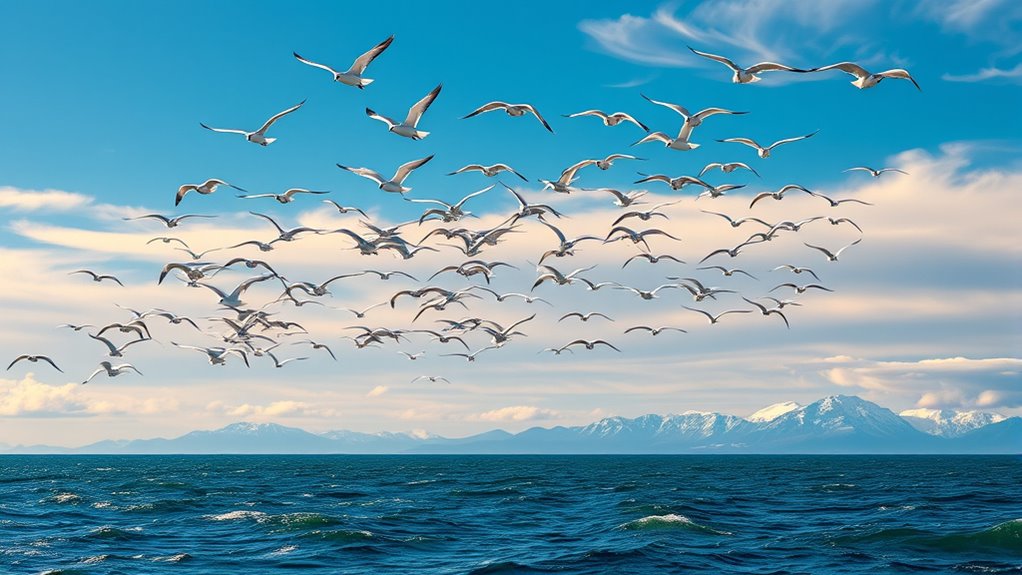Many incredible animal migrators use Earth’s magnetic field as an internal compass to guide their long journeys across oceans and continents. They also rely on environmental cues like the stars, sun, and seasonal changes to stay on track. These sophisticated navigation skills help them reach breeding or feeding grounds precisely when conditions are best. If you want to discover how these creatures master such amazing feats, you’ll find fascinating details ahead.
Key Takeaways
- Many animals use Earth’s magnetic field as an internal compass to navigate long-distance migrations.
- They combine magnetic cues with environmental signals like stars and the sun for precise orientation.
- Specialized receptors, such as magnetite particles, detect magnetic fields in animals like birds and sea turtles.
- Migration timing is synchronized with seasonal cues, ensuring arrival during favorable conditions.
- These adaptive navigation skills have evolved over millions of years, enabling accurate, long-range travel.

Have you ever wondered how some animals manage to travel thousands of miles each year without getting lost? It’s a fascinating feat of nature that combines instinct, environmental cues, and remarkable navigation skills. One of the key tools they use is magnetic navigation, which allows them to detect Earth’s magnetic field and orient themselves during long migrations. This sense acts like an internal compass, guiding birds, sea turtles, and even some mammals across vast oceans and continents. When combined with seasonal timing, it becomes even more effective. Seasonal timing helps animals synchronize their migrations with the right environmental conditions, such as food availability and climate. This means they don’t just wander aimlessly; they follow precise schedules that maximize their chances of survival and reproduction.
Magnetic navigation works by animals sensing variations in Earth’s magnetic field through specialized receptors in their bodies. Birds, for example, have magnetite particles in their beaks or brains that respond to magnetic signals, helping them determine direction even in cloudy weather or at night. Sea turtles, too, seem to rely on this magnetic sense to find their natal beaches after years at sea. Understanding animal navigation is crucial for conservation efforts, especially as environmental changes threaten migratory routes. The development of navigation mechanisms has allowed these creatures to undertake their epic journeys with incredible accuracy over millions of years. Additionally, many animals utilize environmental cues such as celestial navigation, which involves using stars or the sun for orientation during migration. Seasonal timing plays a vital role because many animals start their migration at specific times of the year, often triggered by changes in daylight length or temperature. This guarantees they arrive at breeding or feeding grounds when conditions are most favorable, reducing the risk of starvation or harsh weather.
Your understanding of these mechanisms reveals how finely tuned these creatures are to their environment. The combination of magnetic navigation and seasonal timing creates a robust system that allows them to undertake perilous journeys with incredible accuracy. It’s not just luck or simple instinct—these animals have evolved sophisticated sensory and behavioral adaptations over millions of years. For instance, some species of whales follow migratory routes that align perfectly with magnetic cues, while birds time their departure to coincide with the spring and fall equinoxes, ensuring they reach their destinations during ideal conditions.
Frequently Asked Questions
Do Animal Migratory Routes Change Over Time?
Yes, animal migratory routes can change over time. You might notice shifts due to genetic factors, which influence navigation skills and instincts. Environmental changes, such as climate shifts or habitat loss, can also cause navigational errors, leading animals to alter their routes. These adjustments help animals adapt to new conditions, ensuring their survival. Over generations, these changes can result in markedly different migratory paths, demonstrating how flexible and dynamic animal navigation systems are.
How Do Baby Animals Learn Migration Paths?
You might wonder how baby animals learn migration paths. They pick up on learning cues from their parents or the environment, which helps them understand navigation techniques. Through observation and practice, they gradually develop the skills needed for long journeys. Over time, these cues and techniques become instinctive, allowing them to follow familiar routes and adapt to changes, ensuring successful migration as they grow.
Are There Any Animals That Migrate Underground?
You might be surprised to learn that some animals engage in subterranean migration, moving underground rather than across the surface. Mole and certain insects use underground navigation, relying on smell, vibrations, and magnetic cues to find food or mates. This subterranean migration helps them avoid predators and harsh weather. These creatures demonstrate that animals can adapt their navigation skills for underground navigation, showcasing an impressive form of underground migration.
How Do Migratory Animals Avoid Predators?
You might wonder how migratory animals avoid predators during their long journeys. They often rely on predator avoidance strategies like camouflage tactics, blending into their environment to stay hidden. Some also use speed or erratic movements to escape threats. Others migrate at night or through dense cover, making it harder for predators to spot them. These tactics help guarantee they reach their destination safely, despite the dangers along the way.
What Impact Do Climate Changes Have on Migration Patterns?
Imagine your travel plans disrupted by climate variability, forcing you to reroute constantly. That’s what migratory animals face with habitat shifts and unpredictable weather. Climate change messes with their timing, making migrations more dangerous or pointless. As temperatures rise and habitats shift, creatures struggle to find food and breeding grounds, risking population declines. So, your inconvenience pales compared to the chaos climate change wreaks on their ancient, crucial journeys.
Conclusion
As you marvel at these incredible migrations, it’s almost as if nature’s secrets were meant for you to discover. Who would’ve guessed that tiny butterflies and massive whales share such extraordinary journeys? Maybe, just maybe, their paths cross with yours someday, revealing the wonder of our interconnected world. After all, isn’t it amazing how life’s coincidences bring us closer to these awe-inspiring stories? Keep exploring — you never know what incredible migrations await your discovery.









